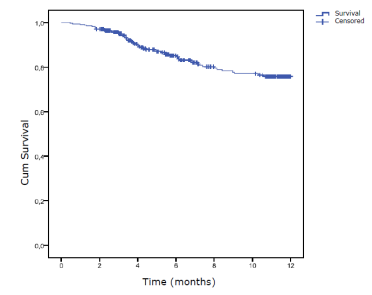Session Information
Date: Monday, November 6, 2017
Title: Spondyloarthropathies and Psoriatic Arthritis – Clinical Aspects and Treatment Poster II
Session Type: ACR Poster Session B
Session Time: 9:00AM-11:00AM
Background/Purpose: Certolizumab pegol (CZP) is available for patients with spondyloarthritis (SpA), including ankylosing spondylitis (AS) and non-radiographic axial spondyloarthritis (nr-axialSpA). CZP has a different molecular structure, the only Fc free PEGylated antiTNF and monovalent. Thus, CZP represents an alternative for solution NSAIDs refractory patients suffering with SpA.
Objective: To evaluate the effectiveness and safety of CZP in a real word setting in SpA patients.
Methods: Multicentric cohort of SpA patients treated with CZP according to routine clinical practice. The study was approved by the local Ethics Committee. Maximum follow-up was 12 months. Clinical response was evaluated through BASDAI, ASDAS,BASFI and MASES scores. Safety variables: discontinuation rate.
Results: 336 patients with axSpA were included: 56.5% male, mean age 45.8 (±12.1) years, median disease time 4.3 (range 0, 49.5) years, 68.5% HLAB27 positive, never smokers 64.7%. Prior bDMARD exposure: (27.2% none; 37.9% 1, 35% ≥2). At baseline, 36.8% had concomitant csDMARDs. Mean duration on treatment with CZP was 10.3 months. 31.8% of patients had peripheral arthritis and 42.7% enthesitis at baseline.
Statistically significant differences in BASDAI, BASFI, ASDAS and MASES were observed at the last visit comparing with baseline (Table 1). In the last observation, 41.0% of the patients achieved BASDAI50, 34% were in ASDAS remission (ASDAS<1.3) and 49% presented a minimal clinical response (ΔASDAS≥ 1.1). Percentage of patients with enthesitis at baseline (42.9%) was reduced to 16.8% at the end of the observation. Finally, 46.3% had resolution of the enthesitis (MASES=0)
Table 1. Evolution of the disease activity variables.
|
|
Baseline |
Last visit |
|
BASDAI evolution (mean ±SD) |
6,2±1.6 |
3,9±2.2 * |
|
BASFI evolution (mean ±SD) |
5,6±2.1 |
3,7 ±2.3 * |
|
ASDAS evolution (mean ±SD) |
3.7±2.7 |
2,4 ±2.2 * |
|
MASES score (mean ±SD) |
3,9 ±2.7 |
1,2 ±1.8 * |
*p<0,001, Wilcoxon’s test
According to Kaplan-Meier analysis, the drug survival of CZP is 83.3% (Figure1), and similar retention rates were observed independently if CZP were used as monotherapy (82.9%) or in combination with csDMARDs (82.6%).
Figure 1.
56/336 (16.7%) withdrawn CZP treatment: 34/336 (10.1%) due to lack of efficacy, 16/336 (4.8%) due to adverse event and 6/336 (1.8%) for other reason. Serious adverse event was found in 23/336 (6.8%) patients.
Conclusion: Real life experience from this nationwide rheumatology study, demonstrated the effectiveness and safety of CZP in patients with SpA, with a significant reduction of BASDAI, BASFI, ASDAS and MASES scores.
This publication has been possible thanks to a grant of UCB Pharma to the technical companies which have been managing the data collection and the statistical analyses. The results are independent of UCB Pharma.
To cite this abstract in AMA style:
Expósito R, Gonzalez CM, García-Portales R, Urruticoechea-Arana A, Lamua JR, Navarro MDP, Rey Rey JS, Fernández M. Effectiveness and Retention Rate of Certolizumab Pegol in Spondyloarthritis. Real Life Data [abstract]. Arthritis Rheumatol. 2017; 69 (suppl 10). https://acrabstracts.org/abstract/effectiveness-and-retention-rate-of-certolizumab-pegol-in-spondyloarthritis-real-life-data/. Accessed .« Back to 2017 ACR/ARHP Annual Meeting
ACR Meeting Abstracts - https://acrabstracts.org/abstract/effectiveness-and-retention-rate-of-certolizumab-pegol-in-spondyloarthritis-real-life-data/

